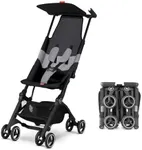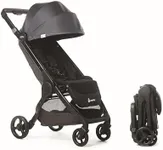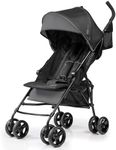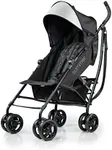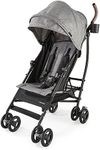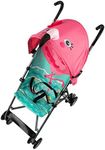Buying Guide for the Best Travel Umbrella Strollers
Choosing a travel umbrella stroller can make your journeys with a little one much easier and more enjoyable. These strollers are designed to be lightweight, compact, and easy to fold, making them perfect for travel, public transport, or quick errands. When picking the right one, it's important to consider your lifestyle, how often you'll use the stroller, and the environments you'll be navigating. Understanding the key features will help you find a stroller that fits your needs and keeps your child comfortable and safe.WeightWeight refers to how heavy the stroller is when it's fully assembled. This is important because a lighter stroller is easier to carry, lift into a car, or take on public transport. Travel umbrella strollers typically range from very lightweight (under 12 pounds) to moderately light (up to 18 pounds). If you plan to carry the stroller often or travel frequently, a lighter model will be more convenient. However, if you need more features or sturdiness, a slightly heavier stroller might be a better fit.
FoldabilityFoldability describes how easily and compactly the stroller can be folded for storage or transport. Some strollers fold with one hand, while others require two. The folded size can vary, with some becoming very compact and others remaining a bit bulky. If you have limited storage space or will be taking the stroller on planes, trains, or buses, look for a model that folds quickly and to a small size. If you'll mostly use it from home to car, a slightly larger fold may be acceptable.
Recline OptionsRecline options refer to how much the seat can tilt back to allow your child to rest or nap. Some umbrella strollers offer multiple recline positions, while others have a fixed or limited recline. If your child will be spending long periods in the stroller or napping on the go, a deeper or adjustable recline is helpful. For short trips or older children who sit upright, a basic recline may be sufficient.
Canopy SizeThe canopy is the cover that shields your child from sun, wind, or light rain. Canopy size can range from minimal coverage to large, extendable canopies with extra panels. If you'll be outdoors often or in sunny climates, a larger canopy provides better protection. For mostly indoor use or quick trips, a smaller canopy may be enough.
Storage BasketThe storage basket is the space under the seat where you can keep bags, snacks, or other essentials. Basket size and accessibility vary between models. If you need to carry a diaper bag, groceries, or other items, look for a stroller with a larger, easy-to-access basket. For minimal needs or very compact strollers, a small basket may suffice.
Harness SystemThe harness system is the set of straps that keep your child safely secured in the stroller. Most umbrella strollers have either a 3-point or 5-point harness. A 5-point harness offers more security, especially for younger or more active children. If your child is older and sits still, a 3-point harness may be adequate, but for maximum safety, especially for infants and toddlers, a 5-point harness is recommended.
Wheel Type and SuspensionWheel type and suspension affect how smoothly the stroller moves and how well it handles different surfaces. Smaller wheels are lighter and better for smooth pavements, while larger wheels and suspension systems provide a smoother ride on uneven ground. If you'll be using the stroller mostly in cities or indoors, basic wheels are fine. For parks, cobblestones, or rougher terrain, look for better suspension and larger wheels.
Age and Weight LimitThe age and weight limit indicate the range of child sizes the stroller can safely accommodate. Some umbrella strollers are suitable from 6 months up to 40-50 pounds, while others may have different limits. Make sure the stroller matches your child's current age and size, and consider how long you want to use it as your child grows.

